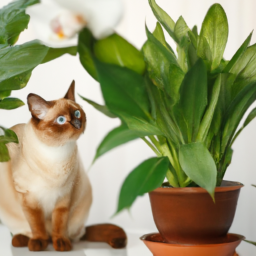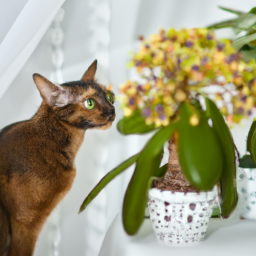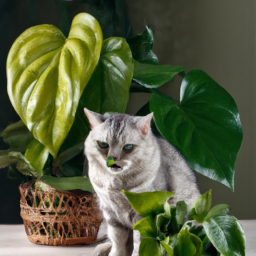
If you’re a cat owner, you probably already know how curious and mischievous our feline friends can be. They love to explore every nook and cranny of our homes, including our indoor plants. But did you know that some indoor plants can be toxic to cats? In this blog post, we’ll discuss which indoor plants are toxic to cats and how to keep your furry friends safe and healthy. So if you’re a plant lover and a cat parent, keep reading to learn more about how to create a safe environment for your pets.
Toxic Indoor Plants for Cats: A Comprehensive Guide
Introduction
Understanding the Dangers
As a cat owner, it’s important to be aware of the potential dangers that certain indoor plants can pose to your feline friend. Cats are curious creatures and may nibble on plants out of curiosity, which can lead to poisoning. To keep your cat safe, it’s crucial to know which indoor plants are toxic and should be kept out of reach.
In this comprehensive guide, we will explore some of the most common toxic indoor plants for cats and provide tips on how to create a cat-friendly environment in your home.
Let’s dive in and learn more about the plants that can be harmful to your beloved pet.
Common Toxic Indoor Plants for Cats
Lilies
Lilies are one of the most toxic plants for cats, especially Easter lilies, tiger lilies, and Asiatic lilies. Ingesting any part of the lily plant, including the leaves, petals, or pollen, can cause severe kidney damage in cats. Symptoms of lily poisoning include vomiting, lethargy, and loss of appetite. If you suspect your cat has ingested a lily, seek immediate veterinary care.
To keep your cat safe, it’s best to avoid having lilies in your home or garden. Opt for cat-friendly plants like cat grass or catnip instead.
If you receive a lily as a gift, make sure to keep it out of reach of your cat or consider displaying it in a room that your cat cannot access.
Philodendron
Philodendrons are popular houseplants known for their lush foliage, but they can be toxic to cats if ingested. The leaves of the philodendron plant contain calcium oxalate crystals, which can cause irritation and swelling in the mouth and throat of cats. Symptoms of philodendron poisoning include drooling, difficulty swallowing, and vomiting.
To protect your cat, consider placing philodendron plants in hanging baskets or on high shelves where your cat cannot reach them. If you notice your cat showing signs of poisoning, contact your veterinarian immediately.
It’s always better to be safe than sorry when it comes to keeping toxic plants away from your pets.
Pothos
Pothos, also known as devil’s ivy, is another common houseplant that can be toxic to cats. Like philodendrons, pothos plants contain calcium oxalate crystals that can cause oral irritation and gastrointestinal upset in cats. Symptoms of pothos poisoning include drooling, vomiting, and difficulty breathing.
To prevent accidental ingestion, place pothos plants in areas that are inaccessible to your cat, such as on high shelves or in rooms that are off-limits to pets. If you suspect your cat has eaten pothos leaves, monitor their symptoms closely and seek veterinary care if necessary.
Creating a safe environment for your cat means being mindful of the plants you bring into your home and taking steps to protect your pet from potential hazards.

Identifying Common Toxic Houseplants for Cats
As a cat owner, it’s important to be aware of the potential dangers that certain houseplants can pose to your feline friend. While many indoor plants can add beauty and freshness to your home, some can be toxic to cats if ingested. In this guide, we will explore some of the most common toxic houseplants for cats and how to identify them.
1. Symptoms of Plant Toxicity in Cats
Before we delve into specific toxic houseplants, it’s important to know the signs of plant toxicity in cats. Common symptoms of plant poisoning in cats include vomiting, diarrhea, lethargy, drooling, difficulty breathing, and changes in appetite. If you suspect that your cat has ingested a toxic plant, it’s crucial to seek immediate veterinary care.
In some cases, plant toxicity can be life-threatening, so it’s always better to err on the side of caution and keep toxic plants out of your home if you have a curious cat.
Now, let’s take a look at some of the most common toxic houseplants for cats:
2. Toxic Houseplants for Cats
Lilies: Lilies are highly toxic to cats, especially Easter lilies, tiger lilies, and Asiatic lilies. Ingesting any part of a lily plant can lead to kidney failure in cats, so it’s best to avoid having these plants in your home if you have a feline friend.
Pothos: Pothos, also known as devil’s ivy, is a popular houseplant that is toxic to cats. Ingesting pothos can cause vomiting, drooling, and difficulty swallowing in cats. Keep this plant out of reach of your furry companions.
Dieffenbachia: Dieffenbachia, also known as dumb cane, is another common houseplant that is toxic to cats. Chewing on or ingesting dieffenbachia can cause oral irritation, swelling, and difficulty breathing in cats. It’s best to keep this plant away from your pets.
3. Tips for Keeping Your Cat Safe
Now that you know which houseplants are toxic to cats, here are some tips for keeping your feline friend safe:
Research Before Buying: Before bringing a new houseplant into your home, research whether it is safe for cats. There are plenty of cat-friendly plants that you can enjoy without worrying about your pet’s safety.
Place Plants Out of Reach: If you have toxic houseplants that you can’t bear to part with, make sure to place them in areas that are inaccessible to your cat. Consider hanging plants from the ceiling or using plant stands to keep them out of reach.
Monitor Your Cat: Keep an eye on your cat’s behavior around houseplants. If you notice that they are showing interest in a particular plant, consider moving it to a safer location or replacing it with a non-toxic alternative.
By being aware of which indoor plants are toxic to cats and taking steps to keep your feline friend safe, you can enjoy the beauty of houseplants without putting your pet at risk.

Safeguarding Your Feline Friends: Indoor Plants to Avoid
Understanding the Dangers of Toxic Plants
Indoor plants can add beauty and a touch of nature to your home, but for cat owners, it’s important to be aware of the potential dangers certain plants can pose to your feline friends. Many common houseplants are toxic to cats and can cause a range of symptoms from mild gastrointestinal upset to more severe reactions. It’s crucial to know which plants to avoid and take steps to keep your curious kitties safe.
One of the most common toxic plants for cats is the lily. All parts of the lily plant, including the petals, leaves, and pollen, are highly toxic to cats and can cause kidney failure if ingested. Other plants to watch out for include philodendron, pothos, and dieffenbachia, which can cause irritation and swelling in the mouth and throat. Even seemingly harmless plants like aloe vera and jade plants can cause gastrointestinal upset in cats.
If you suspect your cat has ingested a toxic plant, it’s important to seek veterinary care immediately. Symptoms of plant poisoning in cats can include vomiting, diarrhea, lethargy, difficulty breathing, and even seizures. Prompt treatment is essential to prevent serious complications and ensure your cat’s well-being.
Common Toxic Plants to Avoid
There are many common indoor plants that are toxic to cats, so it’s important to be familiar with the potential dangers. Some of the most common toxic plants for cats include:
– Aloe Vera: While aloe vera is known for its soothing properties, it can cause vomiting and diarrhea in cats if ingested.
– Philodendron: This popular houseplant contains calcium oxalate crystals that can cause irritation and swelling in the mouth and throat.
– Sago Palm: The sago palm is highly toxic to cats and can cause liver failure if ingested.
– Peace Lily: Peace lilies are beautiful, but they can cause vomiting, drooling, and difficulty swallowing in cats.
– Pothos: Pothos plants contain insoluble calcium oxalate crystals that can cause irritation and swelling in the mouth and throat.
It’s important to research any new plants before bringing them into your home to ensure they are safe for your feline companions. If you’re unsure about a plant’s toxicity, it’s best to err on the side of caution and keep it out of reach of your cats.
Creating a Cat-Safe Environment
To protect your cats from toxic plants, consider creating a cat-safe environment in your home. This can include:
– Choosing non-toxic plants: Opt for cat-friendly plants like catnip, cat grass, and spider plants that are safe for your feline friends.
– Keeping toxic plants out of reach: Place toxic plants in areas that are inaccessible to your cats, such as high shelves or hanging planters.
– Providing alternative greenery: Give your cats their own safe plants to nibble on, such as cat grass or catnip, to satisfy their natural urge to chew on foliage.
By taking these steps and being mindful of the potential dangers of toxic plants, you can help keep your feline friends safe and healthy in your home. Remember, when it comes to your cat’s well-being, prevention is key.
Recap of this article
If you’re a cat owner and a plant lover, it’s important to be aware of which indoor plants can be toxic to your feline friends. Some common houseplants like lilies, aloe vera, and philodendron can be harmful to cats if ingested. These plants can cause symptoms ranging from mild irritation to more serious issues like vomiting, diarrhea, and even organ damage.
To keep your cat safe, it’s best to avoid having toxic plants in your home altogether. Instead, opt for cat-friendly plants like spider plants, Boston ferns, and catnip. These plants are not only safe for your furry friends but can also help improve air quality in your home. Remember to always research any new plants before bringing them into your home to ensure they are safe for your beloved pet.
Top FAQs:
Q1: Are all indoor plants toxic to cats?
A1: Not all indoor plants are toxic to cats. However, there are certain plants that can be harmful if ingested by cats.
Q2: Which indoor plants are toxic to cats?
A2: Some common indoor plants that are toxic to cats include lilies, philodendron, pothos, and peace lilies. It’s important to research and identify any plants you have in your home to ensure they are safe for your feline friend.
Q3: What are the symptoms of plant toxicity in cats?
A3: Symptoms of plant toxicity in cats can vary depending on the plant ingested. Common symptoms include vomiting, diarrhea, lethargy, drooling, and difficulty breathing. If you suspect your cat has ingested a toxic plant, it’s important to contact your veterinarian immediately.
Q4: How can I prevent my cat from ingesting toxic plants?
A4: To prevent your cat from ingesting toxic plants, consider keeping them out of reach or opting for cat-safe plants such as spider plants, catnip, or cat grass. You can also create a designated cat-friendly area with safe plants for your furry friend to enjoy.
Q5: What should I do if my cat ingests a toxic plant?
A5: If your cat ingests a toxic plant, contact your veterinarian or an emergency animal poison control hotline immediately. Provide as much information as possible about the plant ingested and monitor your cat for any symptoms. It’s important to seek professional help as soon as possible to ensure the health and safety of your pet.
Dr. Olivia Green is a botanist with over two decades of experience in indoor plant cultivation. She holds a Ph.D. in Plant Biology and has dedicated her career to researching plant behavior in controlled environments. Dr. Green is passionate about helping plant enthusiasts master the art of indoor gardening through her extensive knowledge and practical insights.


